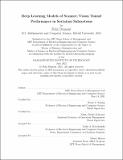Deep Learning Models of Scanner/Vision Tunnel Performance in Sortation Subsystems
Author(s)
Dumont, Felix
DownloadThesis PDF (2.943Mb)
Advisor
Boning, Duane S.
Golrezaei, Negin (Nicki)
Terms of use
Metadata
Show full item recordAbstract
We propose an end-to-end process and tool to deep-dive scanner issues at Amazon’s sorter sites, allowing us to categorize no-reads into operational issues or actual equipment issues.
Our tool sends no-read scanner images to a separate Amazon Web Services (AWS) server and post-processes them through ResNet deep learning models tuned through Bayesian optimization to appropriately assign potential fault reasons. This program will grow the team’s understanding of material handling equipment and best practices to trigger and handle exception case scenarios. A conservative entitlement is approximately $2.2MM for the pilot sites in annual savings excluding customer impact.
Scanner/Vision tunnel performance at Amazon’s large crossbelt sorter sites tends to average around 80-90% read rate success, contributing to a large amount of manual rework and recirculation impacting sorter utilization. Amazon is well away from their target of 98% scanner performance for these sites. Furthermore, the mechanism to deep-dive scanner issues makes it extremely difficult to categorize them into operational issues or actual equipment issues and as a result, we have very little visibility as to no-read causes across sites and cannot properly put together a plan to improve the situation.
A user-friendly interface allows site and operations managers to see which sites are lagging behind, perform a deep-dive into the root cause of the issues and test potential operational or equipment fixes.
Date issued
2021-06Department
Massachusetts Institute of Technology. Department of Electrical Engineering and Computer Science; Sloan School of ManagementPublisher
Massachusetts Institute of Technology